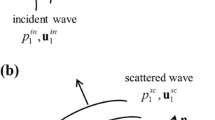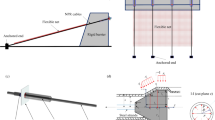Abstract
Two support-interference-free measurements of aerodynamic forces exerted on an archery arrow (A/C/E; Easton Technical Products) are described. The first measurement is conducted in a wind tunnel with JAXA’s 60 cm Magnetic Suspension and Balance System, in which an arrow is suspended and balanced by magnetic force against gravity. The maximum wind velocity is 45 m/s, which is less than a typical velocity of an arrow (about 60 m/s) shot by an archer. The boundary layer of the arrow remains laminar in the measured Re number range (4.0 × 103 < Re < 1.5 × 104), and the drag coefficient is about 1.5 for Re > 1.0 × 104. The second measurement is performed by a free flight experiment. Using two high-speed video cameras, we record the trajectory of an archery arrow and analyze its velocity decay rate, from which the drag coefficient is determined. In order to investigate Re number dependence of the drag coefficient in a wider range (9.0 × 103 < Re < 2.4 × 104), we have developed an arrow-shooting system using compressed air as a power source, which launches the A/C/E arrow at an arbitrary velocity up to 75 m/s. We attach two points (piles) of different type (streamlined and bullet) to the arrow-nose. The boundary layer is laminar for both points for Re less than about 1.2 × 104. It becomes turbulent for Re larger than 1.2 × 104 and the drag coefficient increases to about 2.6, when the bullet point is attached. In the same Re range, two values of drag coefficient are found for the streamlined point, of which the lower value is about 1.6 (laminar boundary layer) and the larger value is about 2.6 (turbulent boundary layer), confirming that the point-shape has a crucial influence on the laminar to turbulent transition of the boundary layer.














Similar content being viewed by others
References
Denny M (2003) Bow and catapult internal dynamics. Eur J Phys 24:367–378
Denny M (2011) Their arrows will darken the sky. The Johns Hopkins University Press, Baltimore
Easton Technical Products (2012) 2012 Easton Catalogue
Foley V, Palmer G, Soedel W (1985) The crossbow. Sci Am 252(1):104–110
French M, Kirk T (2007) Measuring the flight of an arrow using Acoustic Doppler Shift. Mech Syst Signal Pr 21:1188–1191
Herrada MA, Pino CDel, Fernandez-Feria R (2008) Stability of the boundary layer flow on a long thin rotating cylinder. Phys Fluids 20:034105
Kelly HR (1955) A note on the laminar boundary layer on a cylinder in axial compressible flow. J Aerosp Sci 21:634
Kooi BW, Sparenberg JA (1997) On the mechanics of the arrow: Archer’s paradox. J Eng Math 31(4):285–306
Liston TL (1988) Physical laws of archery. Liston and Associates, San Jose
Mukaiyama K, Suzuki K, Miyazaki T, Sawada H (2011) Aerodynamic properties of an arrow: influence of point shape on the boundary layer transition. Proceeding of the 5th Asia-Pacific Congress on Sports Technology, vol 13, pp 265–270
Park JL (2010) The behavior of an arrow shot from a compound archery bow. Proc Inst Mech Eng P J Sports Eng Technol 225:8–21
Park JL (2011) The aerodynamic drag and axial rotation of an arrow. Proc Inst Mech Eng P J Sports Eng Technol 225:199–211
Park JL, Hodge MR, Al-Mulla S, Sherry M, Sheridan J (2011) Air flow around the point of an arrow. Proc Inst Mech Eng P J Sports Eng Technol :1–6 (published online)
Rieckmann M, Park JL, Codrington J, Cazzolato B (2012) Modeling the 3D vibration of composite archery arrows under free-free boundary conditions. Proc Inst Mech Eng P J Sports Eng Techn 226 (2):114–122
Sawada H (2007) Experimental study of aerodynamic performance of arrows with JAXA’s 60cm magnetic suspension and balance system. Theor Appl Mech Jpn 56:237–242
Sawada H, Suda S (2011) Study on aerodynamic force acting on a sphere with and without boundary layer trips around the critical Reynolds number with a magnetic suspension and balance system. Exp Fluids 50:271–284
Seban RA, Bond R (1951) Skin-friction and heat-transfer characteristics of a laminar boundary layer on a cylinder in axial compressible flow. J Aerosp Sci 18:671–675
Suzuki K, Masui K, Mukaiyama K, Miyazaki T, Sawada H (2010) Aerodynamic properties of an arrow: influence of point-shape on the boundary layer transition. Nagare (J Jpn Soc Fluid Mech: in Japanese) 29(4):287–296
Tutty OR, Price WG, Parsons A (2002) Boundary layer flow on a long thin cylinder. Phys Fluids 14(2):628–637
Zanevskyy I (2006) Bow tuning in the vertical plane. Sports Eng 9:77–86
Zanevskyy I (2008) Mechanical and mathematical modeling of sport archery arrow ballistics. Int J Comput Sci Sport 7(1):40–49
Acknowledgments
We are grateful to Prof. Hideo Sawada for his valuable advice in performing the MSBS wind tunnel tests. We also thank Prof. Ken Ohta, Dr. Seiji Sugimoto, and Takahiro Miwa for their kind support throughout the flight experiments at Japan Institute of Sports Sciences (JISS). This work is supported by JISS’s “Team Japan Multi-support Project" entrusted from Ministry of Education, Culture, Sports, Science and Technology.
Author information
Authors and Affiliations
Corresponding author
Appendix
Appendix
We explain in this “Appendix” the details of two data-analysis methods used to estimate the drag coefficient C D [18]. The first is based on the ratio of the horizontal velocity components at Camera 1 and Camera 2. The second utilizes the change of arrow attitude with the gravitational acceleration g. Both methods assume that the forces acting on the arrow are the gravity and the drag, i.e., no lift is exerted on the arrow.
1.1 Method 1: using the horizontal velocity components
Under the previous assumption, the equations of motion are written as,
Here, u and w denote the horizontal and vertical velocity components, respectively. The horizontal and vertical coordinates are x and z, respectively, and s means the length along the trajectory. The velocity decay rate \({\hat D}\) (m −1) is linked with the drag coefficient C D as
Here, m denotes the mass of the arrow.
We can eliminate the time variable t from (3) and (5):
It is solved to give a simple relation:
Here, u 1 is the horizontal velocity component at Camera 1. Then we have \({\hat D}\) in the following form by putting u = u 2 with u 2 being the horizontal velocity component at Camera 2:
Although this relation is exact, it is not easy to determine trajectory length s between Camera 1 and Camera 2, analytically. When the initial velocity is very large, s can be approximated fairly well by the horizontal distance x between the two cameras. However, this approximation becomes too crude for a lower initial velocity, since in this case the vertical velocity component w 1 at Camera 1 cannot be neglected. We then approximate the trajectory by a parabola assuming the drag force is weak compared with the gravity:
Here, a new variable \(\displaystyle{w_1}/{u_1} = {\rm sinh\xi_1}\) is introduced, which is linked to the initial angle of arrow trajectory to the horizontal x-direction. We will see below that a similar variable is conveniently used in the second method of data-analysis.
1.2 Method 2: using the arrow attitude
The vertical component of the equations of motion (4) can be solved by using the variable \({w}/{u} = {\rm sinh\xi}\) or putting
Here, we use the relation (8). After some algebra, we find that the variable ξ(s) is governed by the following differential equation:
in which time t is eliminated using (5) again. This equation is easily integrated to yield the following relation:
Since we know ξ1,2 and u 1,2 from the video images, \({\hat D}\) is calculated using g = 9.80 m/s2. Note that the second method does not require the distance between the two cameras, and that it is more convenient in outdoor measurements.
Rights and permissions
About this article
Cite this article
Miyazaki, T., Mukaiyama, K., Komori, Y. et al. Aerodynamic properties of an archery arrow. Sports Eng 16, 43–54 (2013). https://doi.org/10.1007/s12283-012-0102-y
Published:
Issue Date:
DOI: https://doi.org/10.1007/s12283-012-0102-y




